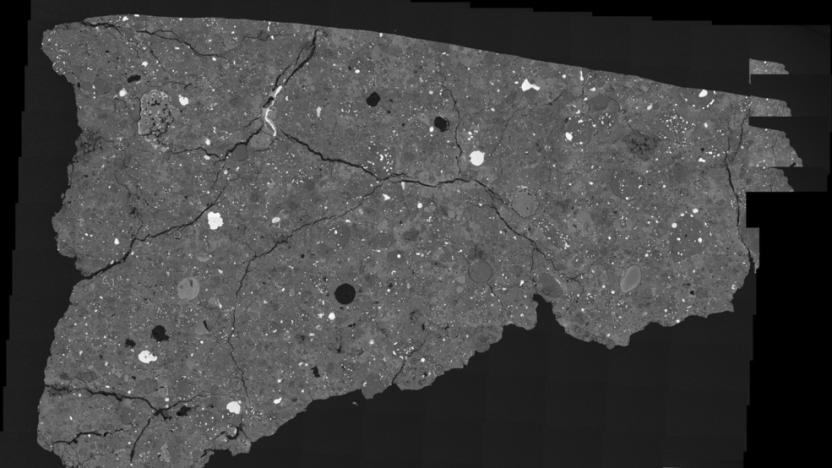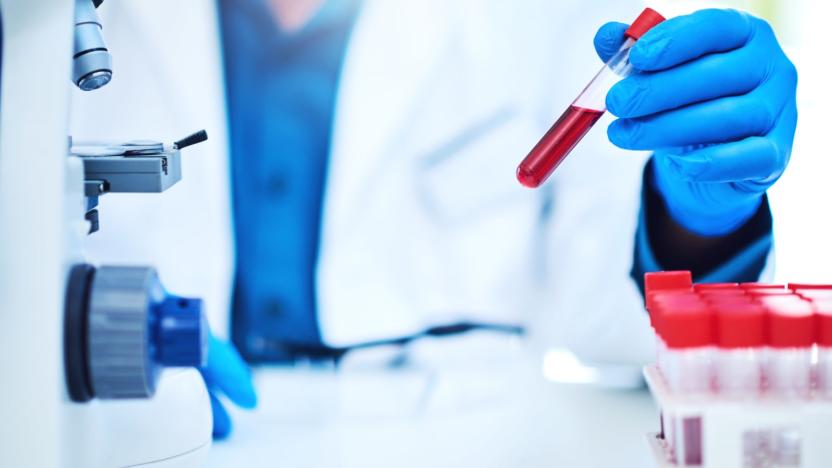proteins
Latest

A tiny space rock holds clues about the evolution of life
NASA researchers believe meteorite Asuka 12236 holds clues about the evolution of life as we know it.

A new blood test could indicate multiple conditions with one sample
A new blood test could use a single plasma sample to assess health and predict the likelihood of developing a range of diseases. Thanks to Theranos, this may sound familiar, but unlike that debacle, this proof-of-concept is backed by research published in Nature Medicine.

Scientists reverse Alzheimer's-like symptoms in mice
Scientists have discovered a way of counteracting the proteins that cause Alzheimer's-like symptoms including memory loss. In mice, at least. Whereas other treatments have focused on beta-amyloid clumps (which the University of Michigan recently discovered how to "fingerprint"), researchers at Washington University in St. Louis, Missouri focus on tau protein tangles. Specifically, the genes that produce them.

Self-assembling material could produce artificial veins
Most attempts at creating artificial veins don't come close to replicating organic processes, but researchers at the Queen Mary University of London might change that. They've developed a technique that makes proteins and peptides self-assemble into tubular shapes that could stand in as arteries, veins and similar structures. There's no 3D printing or moulds involved -- you only need to guide the material as it builds itself. It can even grow and heal, so you're not stuck if it needs improvements.

Lab-grown 'real' cheese made without milk
Real vegan cheese. An oxymoron, but maybe not for long. A group of biohackers, which is a thing now, reckon they can make cheese without milk. Better still, it apparently tastes like proper, legitimate cheese, and not some vegan-friendly substitute mess. The SF-based iGEM group say it's made from baker's yeast. The team is able to make cheese proteins using genetic sequences found in mammals, inserting the DNA blueprints into the aforementioned yeast, and it's all vegan-compatible because it doesn't need animal products to make the proteins.

Video of protein movement within a neuron shows how our brains renew themselves
If, like us, you spend most of your time wondering exactly what's going on in other people's heads, then this video is for you. Okay, so it might not reveal the reason why that jerk cut you off at the junction, or why that co-worker didn't show up to your date exactly, rather, it's a little more literal than that. This is video footage of proteins moving within a single neuron. The USC researchers were able to capture this video by using bioluminescent proteins from a jellyfish to visually track their movement. Not only is this mind-boggling to the layperson (just think how small these things are) it's also mind-revealing. By that, we mean it gives scientists an opportunity to observe how these tiny, yet vital, cerebral elements restore themselves. Which, when you're constantly worried about the amount of grey matter you were blessed with in the first place, can only be a good thing.

Tel Aviv University develops biodegradable transistor, literally man made
Blood sweat and tears go into many projects, and in this case almost literally -- although technically it's blood, milk and mucus. Yep, researchers at Tel Aviv University have created biodegradable transistors from proteins found in the aforementioned organic substances. When the proteins are mixed with base materials in the right combinations, it seems they self-assemble into a semi-conducting film. Why blood, milk and mucus? Apparently, the different proteins each have unique properties. Blood's oxygen storing ability, for example, helps mix chemicals with semi-conductors to give them specific properties, while milk and mucus (the only time we want to see them together) have fiber forming, and light-creating properties respectively. The hope is that this can lead to flexible and biodegradable technology. The team at Tel Aviv says it's already working on a biodegradable display, with other electronic devices to follow -- which should help stem the flow of waste.

Gamers pwn University of Washington scientists, solve decade-long simian AIDS protein conundrum (video)
No gamer's escaped the throes of adolescence without hearing the damning refrain, "Video games'll rot your brain." While scientific research into that claim has so far proved inconclusive, it turns out the preferred pastime of our digital era could potentially cure cancer, and even help prevent AIDS -- in monkeys. Utilizing crowdsourced results from the downloadable protein-manipulating "game" Foldit, scientists at the University of Washington were able to attain a successful model of the simian AIDS-causing Mason - Pfizer monkey virus retroviral protease. For over a decade, researchers have been arduously attempting to reconstruct the folded shape of M-PMV with the aid of the task-specific Rosetta software, but to no avail. Now, in what they're calling a possible first, gamers were able to do what scientific brains and algorithms could not, creating a sufficient model for molecular replacement -- all in just three weeks. Feel like dedicating your leisure hours to this worthwhile cause? Then be sure to hit up the source link below, and transform yourself from couch potato to couch crusader.

Self-assembling DNA circuits could power your next computer
Sick of silicon? It is getting a bit played, so maybe it's time to shift some paradigms, and Duke University engineer Chris Dwyer thinks that pure proteins deoxyribonucleic acids are where it's at. He's demonstrated a way to force DNA to create shapes all by itself, a process he likens to a puzzle that puts itself together: It's like taking pieces of a puzzle, throwing them in a box and as you shake the box, the pieces gradually find their neighbors to form the puzzle. What we did was to take billions of these puzzle pieces, throwing them together, to form billions of copies of the same puzzle. Right now the waffle-shaped structures he can form aren't particularly useful, but going forward the hope is that nearly any type of circuitry could be made to build itself in massive quantities at next to no cost. It sounds exciting, promising, almost utopian -- exactly the kind of research that we usually never hear of again. Update: We've had a few people commenting on the inaccuracy of the word "proteins" above, so it's been fixed and we hereby invite all you armchair molecular biologists to get back to curing cancer already.

IBM concocts microscope with ultra-fine resolution, current MRI bows down
The existing MRI has certainly been beneficial to humans everywhere, but IBM researchers are adamant on doing it one better. These gurus, working in tandem with the Center for Probing the Nanoscale at Stanford University, have demonstrated "magnetic resonance imaging (MRI) with volume resolution 100 million times finer than conventional MRI." What it's all mean? In short, it could give scientists the ability to investigate complex 3D structures at the nanoscale level, and according to IBM, it may "ultimately be powerful enough to unravel the structure and interactions of proteins." We know, only the nerdiest of you are amazed -- nay, affected whatsoever -- by that statement, but even the layperson can appreciate advanced methods of studying viruses, bacteria and other biological elements. A certifiably riveting demonstration vid awaits you beyond the break.[Via TG Daily, thanks Speedy]

Protein-coated discs could enable 50TB capacities
We know that it shouldn't come as a shock anymore when researchers announce new storage technologies that promise to hold tantalizingly large amounts of data, but we were still pretty stoked to learn that a recent breakthrough at Harvard Medical School may eventually lead to DVD-size discs whose capacities approach an eye-popping 50TB. Unlike traditional optical or magnetic solutions, the disc developed by Professor V Renugopalakrishnan and his colleagues is coated with thousands of light-activated proteins called bacteriorhodopsin which are found in the membrane of a particular salt marsh microbe -- and which temporarily convert to a series of intermediate molecules when exposed to sunlight. That property allows the proteins to act as individual bits in a binary system, but since they have a tendency to return to their grounded state after mere hours or days, Renugopalakrishnan and his team modified the requisite microbes' DNA to produce proteins capable of maintaining that intermediary state for several years. Unfortunately we won't see this technology come to market anytime soon, and even when it does, 50TB capacities will still be a ways off, so it looks like we'll have to settle for those disappointing 200GB Blu-ray discs for the foreseeable future.[Via Gotakon]







